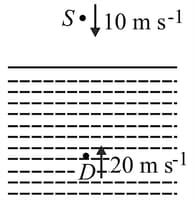Beats
Beats: Overview
This topic covers concepts, such as, Beats in Waves & Resultant Beat Equation etc.
Important Questions on Beats
When two tuning forks and are sounded together a beat frequency of is produced. When in waxed and again and are sounded together the beat frequency increased to . If the frequency of in , the frequency of fork (before it is waxed) maybe
A person riding on a source '' of sound (frequency ) moves in a medium (in which velocity of sound is ) with speed as shown towards a liquid reservoir (in which velocity of sound is ). A detector '' in the reservoir moves towards the free surface of the reservoir (along line ) at a speed . The sound produced by '' gets reflected and transmitted at the free surface. Mark the INCORRECT statement(s) among the following, assuming the liquid in the reservoir stays still and calm.

There are four tuning forks, and one of them has frequency . By using any two forks at a time, the beat frequencies heard are . Which of the following could be a possible set of frequencies of other three forks.
There are four tuning forks, and one of them has frequency . By using any two forks at a time, the beat frequencies heard are . The possible frequencies of other three forks are
Two notes and , sounded together, produce 2 beats per . Notes and sounded together produces 3 beats per second. The notes A and C separately produce the same number of beats with a standard tuning fork of . The possible frequency of the note is
If the two frequencies of waves are respectively. The beat frequency is _____.
Two tuning forks have frequencies and respectively. On sounding these forks together, the time interval between two successive maximum intensities will be _____.
Two waves each of loudness superimpose to produce beats. The maximum loudness of beats will be
Two tuning forks have frequencies and respectively. On sounding these forks together, the time interval between two successive maximum intensities will be _____.
Two sound waves of wavelength and produce beat in in a medium. The velocity of sound in that medium is
Two tuning forks have frequencies and . When they are sounded together, after hearing the maximum sound, how long will it take to hear the first minimum sound?
Two sound waves having wavelengths of and respectively, when superimposed, produce beats per second. Find the velocity of the sound.
Describe Quincke's tube experiment to explain the phenomenon of beats.
Consider a source of frequency . In an experiment with sources, the source produces , respectively. Find
A beat frequency of is observed if a tuning fork is vibrated simultaneously with a string under a tension of . However, no beats are heard with the tuning fork when the tension in the string is increased to . Find out the fundamental frequency of the tuning fork.
For which of the following cases, does the phenomenon of beats can take place?
Musicians make use of which phenomenon with their musical instruments?
Two identical piano wires are kept under the same tension and both have a fundamental frequency of What should be the fractional increase in the tension of one of the wires so that are heard when both the wires oscillate together ?
Two tuning forks and are sounded together and it results in beats with frequency of beats per second. When is loaded with wax, they again produces beats per second. If frequency of is , then the frequency of is
